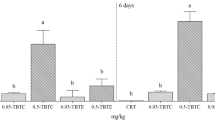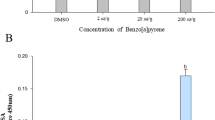Abstract
Accumulation of tributyltin (TBT) was determined in liver of olive flounder exposed to TBT (3.65, 36.5, 365, 3,650, and 7,300 ng Sn/L) for 10 or 30 days, followed by 60 days depuration. Effect of TBT on hepatic cytochrome P450 content was also measured in liver of olive flounder. TBT was highly accumulated in liver of fish during the 10- to 30-day exposures, and hepatic cytochrome P450 content decreased with increasing TBT concentration. Hepatic cytochrome P450 contents were affected in olive flounder exposed to even environmentally relevant TBT concentrations, such as 3.65 ng Sn/L. In addition, the liver TBT levels demonstrated strong negative correlation to the hepatic cytochrome P450 content. The effects started to appear from 20 ng Sn/g dry weight of TBT in liver. Tributyltin concentrations and hepatic cytochrome P450 were also determined in feral fine-spotted flounder. The relationship between other organic pollutants known as cytochrome P450 inducers (e.g., polychlorinated biphenyls) as well as TBT and hepatic cytochrome P450 in the feral fish implied that TBT even at ppt level could impose antagonistic effects on hepatic cytochrome P450 induction.
Similar content being viewed by others
Author information
Authors and Affiliations
Additional information
Received: 15 March 2002/Accepted: 6 August 2002
Rights and permissions
About this article
Cite this article
Shim, W., Jeon, J., Hong, S. et al. Accumulation of Tributyltin in Olive Flounder, Paralichthys olivaceus: Its Effect on Hepatic Cytochrome P450. Arch. Environ. Contam. Toxicol. 44, 0390–0397 (2003). https://doi.org/10.1007/s00244-002-2054-x
Issue Date:
DOI: https://doi.org/10.1007/s00244-002-2054-x




